
The 2006 edition of Marmomacc took place in Verona, Italy, and it drew over 65,000 attendees from around the world.
When the 41st edition of Marmomacc took place from October 5 to 8 in Verona, Italy, it once again confirmed its place as the leading stone fair in the international marketplace. The event featured 1,500 exhibitors from 52 different nations, and it drew 65,000 attendees from around the world. The VeronaFiere fairgrounds have also expanded, with new space and a re-organized layout covering a net area of over 750,000 square feet.

The 2006 edition of Marmomacc took place in Verona, Italy, and it drew over 65,000 attendees from around the world.

The fairgrounds included two new halls for companies displaying
finished natural stone products - Halls 10 and 11, representing 215,000
square feet of space.
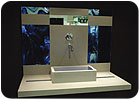
In addition to traditional materials, stone exhibitors at Marmomacc have made efforts to introduce new exotic materials.
Show organizers attribute the success of Marmomacc in part to the importance of stone production in Italy. They pointed out that Italy boasts more than 11,000 companies in the stone sector, employing 60,000 workers and generating an annual turnover of $3.76 billion. After the slowdown in recent years, the field is showing significant signs of recovery, as pointed out by many Italian and international operators.
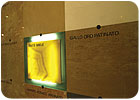
In addition to traditional materials, stone exhibitors at Marmomacc have made efforts to introduce new exotic materials.
Exhibits
The exhibits at Marmomacc were highlighted by several new innovations. These included the inauguration of two new halls for companies displaying finished natural stone products - Halls 10 and 11, representing 215,000 square feet of space. Additionally, Hall 7, the largest ever of its kind, showcased tools, abrasives and chemical products for stone processing. There were also halls for architecture and design exhibitions, stoneworking machinery and outside areas where the focus was on blocks and slabs.Historically, stone suppliers have relied on Marmomacc as a forum to showcase their latest introductions in terms of materials, products and finishes, and this year was no exception. In addition to traditional materials from around the world, attendees at the exhibition could find a broad range of exotic stone offerings in shades of green, gold, blue and other colors. New surface finishes were also introduced, including a new finish for slabs that is smooth, yet textured.

Manufacturers of stoneworking machinery often use Marmomacc as a
platform to introduce their latest equipment to the marketplace.
Also of interest to stone countertop fabricators, exhibitors at Marmomacc 2006 also showcased new chemical products for stone care and maintenance - including products to help fabricators effectively process resin-treated slabs, which are a fast-growing trend in the industry.

- Grein Ernst GmbH (represented by Grein Italia of Affi, Verona) - 150 years
- Margraf S.p.A., Chiampo, Vicenza - 100 years
- Benetti Macchine S.p.A. Carrara, Massa Carrara - 80 years
- AMI S.p.A. Abrasivi Metallici, Desio, Milan - 50 years
- Antolini Luigi & C. S.p.A., Sega di Cavaion, Verona - 50 years
- Ferriera Di Cittadella S.p.A., Cittadella, Padua - 50 years
- Gaspari Menotti S.p.A., Carrara, Massa Carrara - 50 years
- Tenax S.p.A., Volargne, Verona - 50 years


Marble Art Culture
In 1985, Marmomacc began encouraging dialogue with architects, designers and the university world through a series of events focusing on contemporary stone architecture. The awards, shows and programs organized during the 20 editions of “Marble Art Culture” were illustrated in June of 2006 at the Milan Triennial during the Press Conference presenting the 41st Marmomacc.

A display of stone sculpture could also be found on the Marmomacc
fairgrounds. This piece by Simona Bocchi is entitled “Riflessione
Cosmica” (Cosmic Reflection), and it was completed over the course of
two months. The statue was created from the region’s renowned Rosso
Verona marble, and the sculptress took special care to reveal the
marble’s natural fossilization. It represents a man with a broken wing,
and the artist described the work as an “invitation to listen and to
dialogue with the universe. The blurred lines define its traits, so
that the shapelessness becomes shape, which proves the concept of
mutability of things.” For more information, visit www.simonabocchi.it.
“Designer Benches” was another showcase, in which noted architects designed benches to be placed in historic areas of Verona, such as the Castelvecchio, Castel San Pietro and the Giardino alla Tomba di Giulietta (Garden of Juliet’s Tomb), among other locations.
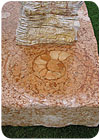
A display of stone sculpture could also be found on the Marmomacc
fairgrounds. This piece by Simona Bocchi is entitled “Riflessione
Cosmica” (Cosmic Reflection), and it was completed over the course of
two months. The statue was created from the region’s renowned Rosso
Verona marble, and the sculptress took special care to reveal the
marble’s natural fossilization. It represents a man with a broken wing,
and the artist described the work as an “invitation to listen and to
dialogue with the universe. The blurred lines define its traits, so
that the shapelessness becomes shape, which proves the concept of
mutability of things.” For more information, visit www.simonabocchi.it.
Another relationship involving natural stone was examined in the session “Women in Marble,” which included Milan fashion designer Nanni Strada, Italian journalist Amalia Zordan and Spanish architect Benedetta Tagliabue Miralles among its presenters. The presentation focused on “feminine” quality of natural stone - which has been traditionally thought of as a “monolithic” material. Among the concepts examined was the relation of veining patterns and waves to “classic female” element.

A display of stone sculpture could also be found on the Marmomacc
fairgrounds. This piece by Simona Bocchi is entitled “Riflessione
Cosmica” (Cosmic Reflection), and it was completed over the course of
two months. The statue was created from the region’s renowned Rosso
Verona marble, and the sculptress took special care to reveal the
marble’s natural fossilization. It represents a man with a broken wing,
and the artist described the work as an “invitation to listen and to
dialogue with the universe. The blurred lines define its traits, so
that the shapelessness becomes shape, which proves the concept of
mutability of things.” For more information, visit www.simonabocchi.it.
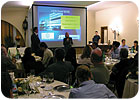
Once again, VeronaFiere held its AIA-accredited course on stone and architecture at Marmomacc. The program was led by industry veteran Vince Marazita (left) and Janina Mathiasz, head of VeronaFiere’s Foreign Department (center). The course, which is co-sponsored by Stone World and recognized by the Royal Architectural Institute of Canada and the Royal Institute of British Architecture, has been recognized as a “Best Practices and Trends” program by the AIA.
Sidebar: AIA course continues at Marmomacc 2006
Long recognized as an official “education provider” by the American Institute of Architects (AIA), VeronaFiere continued its architecture course at Marmomacc 2006. The eighth edition of “Designing with Natural Stone” was held from October 4 to 7 in Verona, Italy, and it included classroom and on-site seminars concerning stone quarrying, processing and specific architectural applications.The course, which is co-sponsored by Stone World and recognized by the Royal Architectural Institute of Canada and the Royal Institute of British Architecture, has been recognized as a “Best Practices and Trends” program by the AIA.
On the first day of the course participants traveled to a porphyry quarry outside Trento, where they learned how this stone is quarried, processed and installed. The course continued with an architectural tour of Trento, which revealed the use of porphyry in buildings throughout the city. Excavations of the ancient Roman city of Tridentum, on which Trento was built, offered the class an opportunity to observe various uses of local stone going back to the second century BC.
In subsequent days, the course included a variety of seminars on aspects of the sourcing and selection of natural and engineered stone. In addition, the architect “students” were given an architectural tour of Verona and a guided tour of the Marmomacc trade fair. One of the architects noted that “the show added another layer of content and exposure that is really important when trying to present a ‘broad-stroke’ perspective on the stone industry.” Participating architects received 19 AIA Learning Units, most of which also counted as HSW credits.
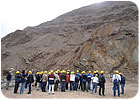
On the opening day of the program, course participants visited a porphyry quarry owned by Odorizzi Porfidi in Trento.
The 17 participating U.S. architects were virtually unanimous in their positive reaction to the course:
- "[The course was] terrific on all ends. The range of information was wonderful and it blended so many aspects of the stone industry seamlessly." - Stephanie Vierra, Steven Winter Associates, Washington, DC
- "To gain an understanding of all facets of natural stone - quarrying, manufacturing, selection and application - is invaluable...an A+ event." - Mark Higa, WCIT Architecture, Honolulu, HI
- "[The course] felt very global and intellectually stimulating [and] also worked well as networking." - Matt Dubbe, Architectural Alliance, Minneapolis, MN
- "The visits to the quarry and finishing plants were worth the trip." - Christine Reynolds, Wiss, Janney, Elstner Associates, Fairfax, VA

Carlo Odorizzi, the company’s export manager (center), explained the technical characteristics of porphyry and how they apply to architectural applications.
An AIA-approved online introduction to the course is available atwww.aecdaily.com/sponsor/veronafiere.
Sidebar: Touring the exhibit halls of Marmomacc 2006
Every year, suppliers from around the world rely on the Marmomacc Fair in Verona, Italy, to showcase their latest offerings to the stone industry. The following is a sampling of the products on display at Marmomacc 2006.Stone Suppliers
Andrade SA- Imperial Coffee, from the company’s own quarry in Brazil, which has a rich brown tone with lighter accents, available in blocks, slabs and tiles
Circle No. 322
Antolini Luigi & C.- on the occasion of the company’s 50th anniversary, it showcased the Shellstone Collection, a line of semi-precious exotic stone materials such as mother of pearl
Circle No. 321
Bermarmol- an array of marble products such as Crema Marbella, which is characterized by flecks of darker shades of beige; Zarci Imperial, a rose-colored stone with slight hints of beige veining; and Travertino Crema Ley, a blend of soft tones of beige
Circle No. 320
Bresciana Graniti- Mascarello granite from Brazil, which has a golden tone with accents of gray, maroon and black; Wild Wine from Brazil, which has waves of red and green
Circle No. 319
Caesarstone- Concetto, a surface made from individually cut and bound semi-precious stones
Circle No. 318
Campolonghi Group- introduced a new “leather” finish for its products, which has a velvet-like feel that is soft, yet textured; the finish maintains the original color as opposed to flaming
Circle No. 317
Chengdu Zaijian Decorating Materials Co.- specializes in the production of mosaics, offering a wide spectrum of marble, lava stone, glass and metal mosaics in a variety of patterns
Circle No. 316
Cremar- Antic Green, which has a one-of-a-kind blend of colors, including green, white, red, rust and brown
Circle No. 315
Dimpomar- a collection of stone from Portugal, including the well-known Rosa Aurora marble; supplies stone for both interior and exterior architectural applications
Circle No. 314
Fratelli Poggi- a selection of travertine from its own quarries in Tivoli, Italy, as well as a range of granite and marble
Circle No. 313
Gem Granites- introduced several new granite varieties, including Forest Yellow, which is gold in color, and Platinum Pearl, featuring a light gray field with flecks of burgundy and peach
Circle No. 312
Granasa- Four Seasons granite, which has a dark gold tone with lighter gold and brown accents
Circle No. 311
Granitex- Oro Fino granite, which has a rich golden tone with waves of darker gold, brown and white as well as gray and black accents
Circle No. 310
Grein Italia- Snow Flakes granite from Brazil, which has a black background with white accents that form the shape of snowflakes; Blue Sodalite from Brazil, which has a rich blue tone with white accents
Circle No. 309
Grupo Galrao- a range of marble and limestone products from Portugual, including marbles in tones of pink, tan and white and limestones in shades of tan and beige
Circle No. 308
Henraux- Cervaiole, a variety of white marble from the Carrara region of Italy, which features distinctive patterning; the material can be bookmatched or backlit for a one-of-a-kind look
Circle No. 307
International Italmarmi- a broad selection of onyx from quarries in Turkey and Pakistan; also Sodalite Blue, which is quarried in the Bolivian Andes and is ideal for interior wall cladding and flooring
Circle No. 306
Jacigua- Napoleone Gold granite, which has a gold and light tan color with accents of black and maroon; Santa Helena granite, which has a more “vertical” pattern of gold, yellow, black, gray and maroon
Circle No. 305
La Ponte Marmi- offered a collection of granite slabs from around the world, including African Beige, Golden Meadow and Odyssey
Circle No. 304
Levantina de Granitos- Everglades granite from Brazil, which has tones of green, ivory, rosewood and smoke gray in an uneven and soft pattern; available in polished and riverwashed finishes
Circle No. 303
M+Q Italia- an extensive selection of exotic stones from around the world, including Macaubas Yellow quartzite, a gold-colored stone with dark gold veining
Circle No. 302
Madhucon- Tropical Green, which has tones of light green and light blue with maroon accents
Circle No. 301
MAP- a collection of mosaics in slate and quartzite, including tones of black, gray, green, tan, purple and multicolor
Circle No. 300
Marcolini Marmi- introduced a line of semi-precious stones; also showcased a collection of other stone varieties, including Verde Lapponia, Labradorite Australe and Ivory Beauty
Circle No. 299
Marmi Bruno Zanet- several new granite varieties, including Mascarello from the state of Bahia in Brazil, which has an intense color that blends light tones of gray with brilliant orange veins; also, Matrix granite from Minas Gerais, Brazil, available in both satin and glossy finishes, which has a black background illuminated by glittering silver spots
Circle No. 298
Marmi La Precisa- a variety of colors from the Crystal Glass Stone Collection from Lavamar, the company’s own quarry near Rimini in the northeast part of Italy; material is from the same family as onyx and alabaster and slabs are laminated with scratch-proof glass
Circle No. 297
Marmocil- Gold Fields, which has a deep blue color with gold accents
Circle No. 296
Michelangelo- Creme Brule granite, available in polished and honed finishes, which features an undulating pattern of brown and caramel tones
Circle No. 295
Marbella- Madreperola marble, which has waves of green and light blue
Circle No. 294
Marbrasa- White Desirée, which has a cool white and gray tone with gray and black crystals
Circle No. 293
Pemagran- introduced a new antique finish for its existing line of materials, which is achieved by flaming and brushing the material; the finish is especially suited for exterior applications
Circle No. 292
Pokarna- introduced a variety of new exotic granites, including Cappuchino Mocha - a blend of dark and lighter brown waves, and Tan Brown Classic - featuring a grayish blue color field accented by flecks of dark chocolate and lighter shades of brown; also introduced its new “silk” finish, which has a honed look with a light textured feel
Circle No. 291
Rock of Ages- a new architect sample book with six removable tiles, includes information pertinent to meet each architect’s specific needs; only available to qualified architects
Circle No. 290
Silkar- introduced Dark Olive marble from its own quarry in Turkey
Circle No. 289
Tekmar- Gold Galaxy marble, featuring a soft golden hue with subtle beige veining; also introduced Coral Beige marble
Circle No. 288
Tracomal- Ice Blue, which has white crystals and black accent lines; Nathalia Gold granite, which has a golden color with waves of gray and black
Circle No. 287
Tureks- Metropolitan™ Stone Collection, consisting of four distinct yet coordinating colors with geometric designed decorative components which can be used as field tile or cut into borders or accents
Circle No. 286
Equipment and Tooling
Breton- the Combicut DJ/NC500, which combines the speed of a regular saw with the flexibility and capability of a waterjet; the unit allows users to execute all of the straight cuts with the blade, while the corners are finished with the waterjet
Circle No. 285
CMS/Brembana- a new 5-axis Maxima stoneworking center, which features the standard Maxima base and increased power of 40 horsepower on the spindle; additionally, the company re-designed the mechanism to withstand granite profiling; the 5-axis Maxima can do edge polishing with flat tools as well as inside and outside radius work
Circle No. 284
Comandulli- a range of heavy-duty fabrication equipment, including the Omega 60-100 automatic edge polishing machine, which is capable of gauging/calibration of slabs, straight edges, bevels, grooves, sloping cuts, quirk miters, slot cuts, bullnose and edges with regular round shapes
Circle No. 283
Diamant Boart- the S10 series of universal diamond blades, which was especially developed for cutting granite; new diamond wire that is specifically designed for multiwire machines
Circle No. 282
ECS-Eich- the ECS Compact, an “all-in-one” compact treatment plant that includes a water purifying unit, sludge drying unit, pressure increase pump and fresh water reservoir
Circle No. 281
Ghines- the Systar, a multi-functional manual stoneworking unit for kitchen and vanity tops, which can shape and polish internal and external contours, holes, sink cut-outs, recess drains, grooves, slots and functions; also, the Easybevel, which can transform an angle grinder into a beveling machine
Circle No. 280
GMM- the Rotex 39 bridge saw, which features a rotating head rather than a rotating table, brushless motors and linear bearings on the X axis slide; the control accepts .dxf files and can be loaded via a LAN network
Circle No. 279
Italdiamant- a full range of stone-processing tools and accessories, including dry cutting blades, drill bits, grinding cups and polishing pads for floors
Circle No. 278
Löffler- a complete line of stone fabrication systems, from the modular Löffler Galileo software package to sawing lines, edge processors, CNC machining centers, conveyors and storage systems
Circle No. 277
Marmo Meccanica- the HTO-GARBI, a medium-duty bridge saw featuring motorized bridge movement and a rotatable table, as well as adjustable cutting and movement speed; the saw has a single-beam bridge and a table that measures 118.19 x 63 inches that can be manually rotated and pneumatically locked in any position
Circle No. 276
Marmoelettromeccanica- Master 3500 portable router and Laser 4000 portable saw, a powerful 4 hp machine capable of cutting up to 5-cm-thick material in one pass without the need of a template
Circle No. 275
Omag- the Mill 4X CNC stoneworking center, which is intended for medium-sized and smaller fabrication shops, offering a lower cost and smaller machine footprint; the machine features an automatic tool presetter which completely automates the tool loading process and CNC tool library for new tools to be stored in a 24-position tool rack
Circle No. 274
Pedrini- the M960TG, a numerically controlled bridge saw with a rotating head that can be tilted from 0 to 90 degrees and lock automatically in any position
Circle No. 273
Pellegrini- the Polywire 30 multiple diamond wire saw for slabbing blocks with up to 30 wires at one time
Circle No. 272
Prodim International BV- Proliner® 8-Series, a new version which includes a USB port for easy, direct downloads onto a laptop, PDA or USB memory stick while on the jobsite; the unit is also equipped with an Ethernet port for network connection; a measuring head folds away for easy transport, and it features built-in CAD functionality; in the U.S., the company is represented by Blick Industries in the western states and Innovative Stone in the eastern states
Circle No. 271
Tenax- announced ongoing developments at the company’s R&D lab: a diamond blade with plastic segments, which has been proven to cut accurately in the field; ultra-thin diamond wire for multi-wire block saws, which allows for more slabs to be produced from a block; also, single-use diamond wire for multi-wire block saws
Circle No. 270
Thibaut- the “Quick Table” for CNC machines, a unique integrated handling system that is engineered to save 30% of machine production time; the unit allows operators to prepare their pieces and arrange the suction pads while the machine is working
Circle No. 269
Z. Bavelloni- the EGAR 323-5 N, which has a topless structure and a large-sized working surface, which allows it to process extremely thick pieces, including tops up to 130 inches and blocks up to 23.6 inches as well as slanted planes
Circle No. 268
Zonato- the I-Cut bridge saw, which combines the utility of a traditional saw with the flexibility of a CNC machine; the unit requires no foundation, and it has a multi-functional rotating head that can be programmed for a broad range of functions
Circle No. 267
Installation/Maintenance Products
Akemi- Nano-Effect, a stain repellent with new “nano-effect” technology, for the first time allowing a curing time of only three to five minutes
Circle No. 266
Bellinzoni- Strong 2000, a hydro repellent impregnator that consolidates and protects marble, granite and stone from water and humidity penetration; IDEA H2O, an ecological water-based water and oil repellent for marble, granite and other stone
Circle No. 265
Fila- products for protecting and maintaining all stone surfaces, including: Fila Cleaner, a detergent that cleans deep down but delicately; FilaWet, a topical wet-look sealer especially suited for outdoor surfaces in natural stone that does not yellow or flake with age; and Fila MP/90, a natural-look penetrating sealer for polished surfaces
Circle No. 264
Tenax- Ager Tiger, which is used for the edge of exotic resin-treated materials; the product is formulated to cure slowly, thus fitting the needs of exotic materials, so the color of the edge will perfectly match that of the surface
Circle No. 263

Music legend Bruce Springsteen crossed paths with participants in VeronaFiere’s AIA-accredited course during Marmomacc 2006. Here, course director Vince Marazita (right) looks on as “The Boss” signs autographs for his fellow hotel guests.
Sidebar: Marmomacc tour encounters Bruce Springsteen
Architects participating in VeronaFiere’s AIA-accredited course during Marmomacc 2006 encountered an unlikely visitor on the program’s second day. Music legend Bruce Springsteen, in town to perform at Verona’s historic Arena in Piazza Bra, was a hotel guest among the architects, and he graciously signed autographs and shook hands with several participants.Although Springsteen was in town to perform “The Seeger Sessions,” he broke into one of his classics songs - “Fire” - in honor of Verona’s literary history, much to the delight of the crowd, which broke into wild applause as he sang of the city’s Shakespearian catalysts, Romeo and Juliet.
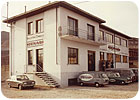
Sidebar: Tenax S.p.A. celebrates 50th anniversary
Tenax S.p.A., one of the Italian leading manufacturers of consumables for the stone industry, marked 50 years of industry service at Marmomacc 2006 in Verona, Italy. Among the initiatives taken to commemorate this milestone, Tenax turned its stand at the fair into a full-scale art gallery, with five famous paintings by Campigli, Tintoretto, Grubacs, Van Honthorst and De Chirico.
Among the initiatives taken to commemorate Tenax’s 50th anniversary, the company turned its stand at the fair into a full-scale art gallery.

The “art gallery” included famous paintings by Campigli, Tintoretto, Grubacs, Van Honthorst and De Chirico.
- Tenax was born in 1956 in S.Ambrogio di Valpolicella, Verona, under the name F.lli Bombana Angelo e Guido. The objective of the company was to start manufacturing mastics for the national and international stone market.
- In 1960, the company started producing magnesite and synthetic abrasives for marble.
- In 1980, the company became Tenax S.p.A., and it began manufacturing magnesite abrasives for granite and the polishing bricks for marble.
- In 1982, due to the untimely passing of Angelo Bombana, the two sons, Igino and Alberto, assumed the control of the company. The company size was 20 employees, and it was generating about 2.5 million Euro of revenue per year (U.S. $3.14 million).
- In 1992, Tenax consolidated its position in the stone industry, due to the introduction of metal-bonded diamond abrasives, cutting tools, fine grain abrasives and epoxy resins.
- In 1992, Ager was also developed.The company size was 42 employees, and it was generating about 8 million Euro of revenue per year (U.S. $10 million).
- In 1998, Tenax started developing its worldwide network of subsidiaries with the opening of Tenax du Brasil (1999) and Tenax USA (2000).
- In 2001, Tenax consolidated the subsidiary structure, adding Tenax Spain, Tenax Toscana, Tenax Sicilia, Tenax Iran and, lastly, Tenax India.
- In 2005, Tenax developed new abrasive technology - Airflex - to create an “antique” finish on antique granite and marble.
- In 2006, new products include new diamond abrasives - Fusion -and new revolutionary projects in the cutting section. The entire group employs about 250 employees and has a revenue of more than U.S. $50 million.

Tenax’s main focus in the future will be in the research and development of new products. One such innovation is the development of a diamond blade using plastic cutting segments.
Tenax’s main focus in the future will be in the research and development of new and technologically advanced products to satisfy the various needs of different geographical areas in the world. It has also organized a new and improved distribution network as well as technical support and free consulting around the world.

Antolini Luigi & C. celebrated its 50th anniversary on a grand scale, with a gala event at the Castelvecchio in Verona, Italy.
Sidebar: Antolini Luigi marks 50 years
Antolini Luigi & C. used the Marmomacc fair in Verona, Italy, to celebrate its 50th anniversary on a grand scale, with a gala event at the city’s legendary Castelvecchio. And at the fairgrounds itself, the company once again made news with its stone “fashion show.” This year, models at Antolini Luigi’s stand modeled outfits that were literally created from the company’s Shellstone Collection, adding yet another twist to the stand’s “nightclub” concept.The following is a look at some of Antolini Luigi and C.’s achievements over the past five decades.
The beginning
The Antolini Family started their business in Sant’Ambrogio di Valpolicella in 1920 with a small workshop, which was progressively enlarged with the purchase of land to open their own quarries, so they had their own material available for production. Through the war years, times were difficult, and a lot of the business suffered. After the war, the business was built up again, and new machinery installed and buildings reconstructed. This period was the start of a new era for the marble industry.
Young Luigi Antolini took the place of his deceased father in the company, which at the time consisted of his uncles. He spent seven years learning his trade, and he eventually specialized in the sales and marketing department. Here, he learned about “new horizons” in the marble industry.
1956
Luigi and his sister, Margherita Antolini, left cousins and uncles, as he felt the need to start his own business to address these “new horizons.” He rented an old workshop in Sant’Ambrogio di Valpolicella, Verona, and established the Antolini Luigi Co. In time, the workshop became too small for the growing business, and so started the growth of the company, which was to become synonymous with the marble industry itself.
1960
The Antolini Luigi Co. moved its business and built a new workshop in Sega di Cavaion on the Adige River, where there was sufficient space for the yard and enough land to expand to cater for the growing business. This is the present location of Antolini Luigi Co., which has seen continuous expansion almost every year since.

Among the many highlights of the event, fire dancers performed at the entrance to the event.
The company started to export to the German market, and established a foothold in what was then the most lucrative granite market in the world. The granite slab business was an innovative product development for Antolini Luigi Co., as the main export products from the area were Rosso Verona and Botticino marbles and some quantities of Carrara marble.
1970
During this period, the company began developing its work in church projects, which proved to be a very important sector for the workshop. Markets for this specialized work were developed all over Europe, including major projects in Eastern Europe.
1975
Luigi Antolini made its first major move to open up the U.S. market for marble and granite. Although the U.S. stone market was small at the time, the Italian dominance in the industry in major cities made communication easier. Business relationships started by Antolini Luigi Co. during this period in the U.S. market continue to this day.
1980
With its progressive development, the Antolini Luigi Co. opened up markets all over the world for marble and granite products. New techniques in stone wall cladding - combined with the growing appreciation of natural stone - generated a major increase in sales.
1986
The high standard of stone craftwork, which was as a result of early investment in “state-of-the-art” machinery, was recognized with the award of the prestigious Italian National Prize “EFBANCA.” This is chosen from all industrial and commercial sectors, and the company won the First National Prize for productivity and economical profitability.
Also, this was the year in which, Alberto, the youngest son of Luigi Antolini, joined the company.
1988
The Antolini Luigi Co. acquired three local granite block processing companies, and incorporated them into a separate new company called “Eurotrading.” This acquisition had the effect of increasing the land devoted to stone production by 1.4 million square feet.
1990
Alessandra, the daughter of Luigi Antolini, joined the company.

The gala dinner included speeches and presentations involving multiple generations of the Antolini family.
The Antolini Luigi Co. acquired a Rosa Beta granite quarry in Sassari, Sardinia, which was working for over 20 years. At the same time, the group purchased a quarry in Creola d’ Ossola for Sarizzo Antigorio stone. Both of these quarries become the property of the Antolini group under the name of “Licci Alti” and “Simplon Graniti.” Eurotrading opened a trading office and block stockyard in Carrara to service its customers in that area of Italy.
1999
Francesco Antolini became President, and Alessandra Antolini became Vice President of the company. Alberto Antolini became General Manager of the company.
Eurotrading opened a trading office and block stockyard in Vigo, Spain, to service the stone market in the Iberian Peninsula. Also at this time as well, Eurobrasil Ltda., a new company in the Antolini Luigi Group, opened a trading office and block stockyard in Vitoria, Espirito Santo, Brazil, to service its customers and the growing demand for Brazilian granite.
2001
The “Stone Boutique” is opened at Antolini Luigi’s facilities, a showroom which displays slabs in precious and exotic marble, granite, onyx and alabaster. The company extends its collection of stone to include a full selection of onyx. At this time, it also starts to market exclusive collections of unique stones.
Land is bought for a new Rosa Beta quarry in Sardinia, in addition to the previously purchased quarry, both belonging to the Antolini group.
2002
Luigi Antolini, the founder of the company, dies.
The “Stone Gallery” is opened, a new concept in presenting stone, which extends its display by over 43,000 square feet. Large book-matched slabs in exotic and exclusive materials are exhibited. This innovative way to exhibit stone slabs, which was first used by the company, has becoming a standard for displaying slabs around the world.
At the 2002 edition of Marmomacc in Verona, the company launches its famous “Stone Fashion Show” at the Antolini Luigi stand.
2003
After just two years, the “Stone Boutique” showroom is extended and completely redesigned. This new “Jewel Box” exhibits precious objects in onyx, alabaster, gems and semiprecious stones - all in large-sized slabs. This showroom is now an important resource for designers and architects looking for unusual and rare natural stones. The company continues to acquire quarries, with the purchase of the Breche de Benou (Breche de Vendome) quarry in the French Pyrenees. This is a noble and ancient stone, used for many centuries to enrich the best mansions in Europe, including the Palace of Versailles.

At this year’s edition Marmomacc, the company once again made news with its stone “fashion show.” This year, models at Antolini Luigi’s stand modeled outfits that were literally created from the company’s Shellstone Collection, adding yet another twist to the stand’s “nightclub” concept.
“Eurotrading Madagascar,” another new company wholly owned by the Antolini Group, is established in Madagascar to manage the Labradorite quarries and other exotic materials from that country.
“Antolini do Brasil” is established as a full-service stone company, equipped with the latest stone fabrication machinery to produce slabs, tiles and cut-to-size pieces for a worldwide market.
The Anolini Luigi Headquarters in Sega di Cavaion has over 2.15 million square feet of space devoted to stone slab inventory, with around 325,000 square feet of covered space. Because of the aggressive development of the business, there are now over 700 different materials available in the stockyard at any time.
2006
Antolini Luigi marks its 50th anniversary in the stone industry.


